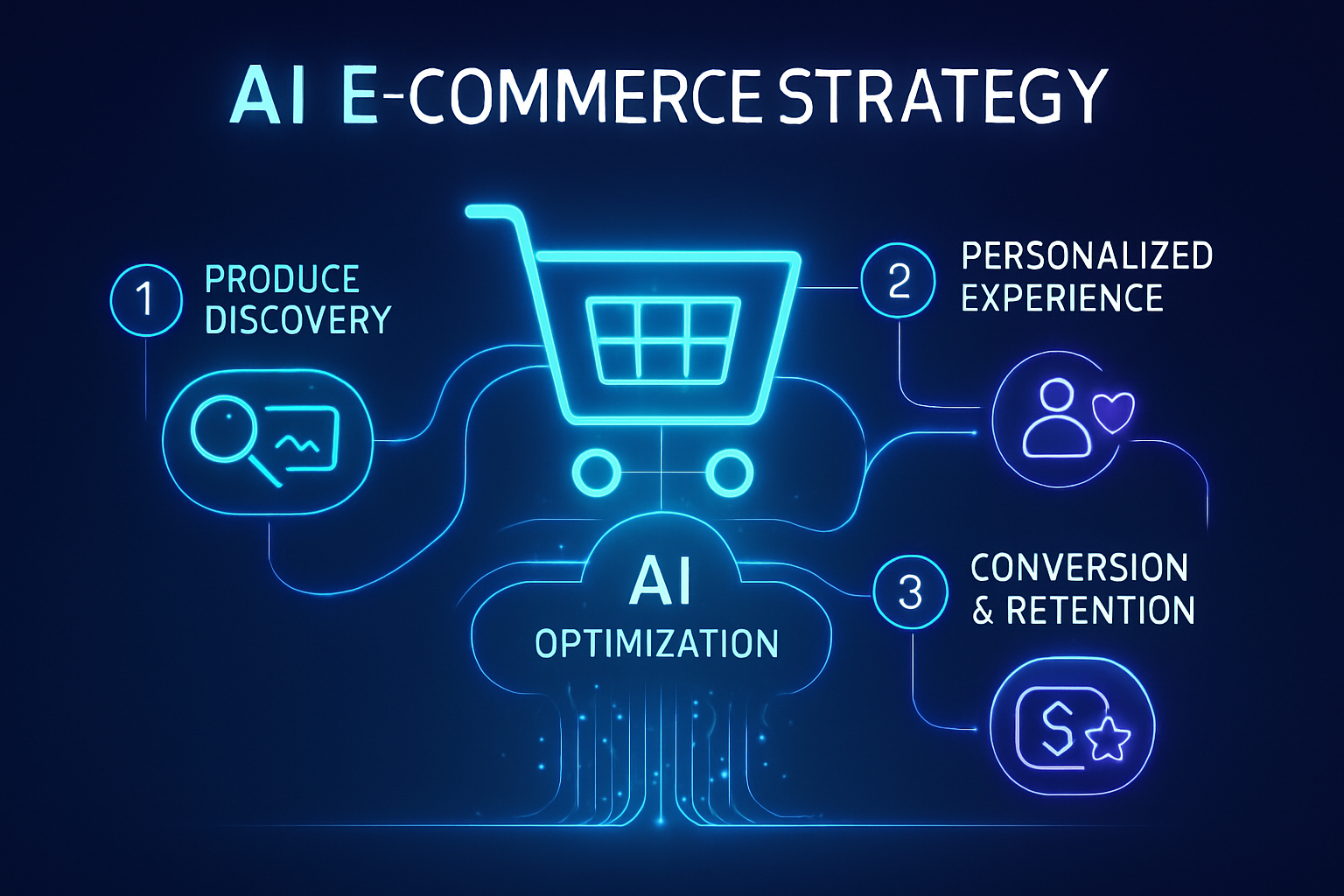AIO Marketing Benefits for E-Commerce Growth in 2025
E-commerce businesses today juggle an average of 12-15 different marketing tools, creating data silos that fragment customer insights and inflate operational costs. While this scattered approach might have worked when online retail was simpler, the $4.3 trillion global e-commerce market projected for 2025 demands a more sophisticated, unified strategy. All-in-One (AIO) marketing platforms are emerging as the solution that transforms fragmented marketing operations into cohesive growth engines. The shift toward AIO marketing isn’t just a trend; it’s a strategic imperative. This is about unlocking exponential growth through unified customer intelligence.
TABLE OF CONTENTS:
- Key Takeaways
- Understanding AIO Marketing in the E-Commerce Context
- Operational Efficiency and Cost Reduction
- Data Unification and Personalization-Driven ROI
- Industry-Wide ROI and Performance Benchmarks
- Strategic Implementation Framework for E-Commerce Success
- Overcoming Common Migration Challenges
- AI-Powered Optimization and Future-Readiness
- Measuring Success: Key Performance Indicators
- Strategic Next Steps for Marketing Transformation
Key Takeaways
- AIO marketing benefits for e-commerce businesses include cost reductions by consolidating multiple marketing tools into one platform, eliminating integration costs, and reducing training requirements while improving operational efficiency by 60-75%
- Unified customer data enables exponential ROI growth
- 76% of marketers achieve positive ROI within 12 months of implementing unified marketing automation, with 44% seeing payback in under six months. Significantly faster than traditional marketing technology investments
- Phased implementation, starting with core function,s maximizes success by focusing on data migration, basic automation, and high-impact workflows before expanding to advanced AI-driven personalization features
- AI-powered optimization becomes accessible through unified platforms, enabling predictive analytics, automated A/B testing, and machine learning-driven campaign optimization that would require custom development in fragmented systems
Understanding AIO Marketing in the E-Commerce Context
AIO marketing platforms integrate multiple marketing functions, customer relationship management, email automation, SMS campaigns, social media management, analytics, and personalization engines into a single, interconnected system. Unlike traditional point solutions that operate in isolation, AIO platforms create a unified data layer that enables sophisticated customer journey orchestration and real-time optimization.
The market validation is compelling. All-in-one marketing platforms represent a $15 billion market in 2025, with a projected 15% compound annual growth rate through 2033. This explosive growth reflects the measurable returns businesses are realizing from marketing stack consolidation.
Operational Efficiency and Cost Reduction
The most immediate AIO marketing benefits for e-commerce businesses manifest in operational streamlining and cost optimization. This comes not just from subscription savings, but from decreased integration costs, reduced training requirements, and elimination of data transfer inefficiencies.
| Operational Area | Traditional Stack | AIO Platform | Efficiency Gain |
|---|---|---|---|
| Campaign Setup Time | 4-6 hours | 45-90 minutes | 60-75% reduction |
| Data Integration | Manual exports/imports | Real-time sync | Instant availability |
| Performance Reporting | Multiple dashboards | Unified analytics | Single source of truth |
| Team Training | 6-8 different interfaces | One platform | 70% faster onboarding |
Data Unification and Personalization-Driven ROI
The most transformative AIO marketing benefits emerge from unified customer data platforms that enable sophisticated personalization at scale. When customer interactions across email, SMS, social media, and website behavior flow into a single database, businesses can create hyper-targeted experiences that significantly boost conversion rates and customer lifetime value.
The personalization capabilities enabled by unified data extend beyond simple email segmentation. Advanced AIO platforms can trigger real-time product recommendations based on browsing behavior, send cart abandonment messages via the customer’s preferred channel, and automatically adjust messaging tone and offers based on purchase history and engagement patterns.
Industry-Wide ROI and Performance Benchmarks

The financial impact of AIO marketing consolidation is supported by comprehensive industry data. Recent cross-industry surveys reveal that 76% of marketers report positive ROI within 12 months of implementing unified marketing automation, with 44% achieving payback in under six months. These timeframes deliver significantly faster returns than traditional marketing technology investments.
The performance improvements extend beyond ROI metrics. Companies implementing AIO marketing solutions typically experience 14.5% increases in sales productivity while simultaneously reducing marketing costs by up to 12.2%. This dual benefit —increased output with decreased investment —creates sustainable competitive advantages that compound over time.
For e-commerce businesses specifically, the benefits manifest in several key areas. Customer acquisition costs decrease through more precise targeting and automated nurture sequences. Customer lifetime value increases through personalized retention campaigns and cross-sell automation. Cart abandonment recovery rates improve through coordinated multi-channel re-engagement strategies.
Strategic Implementation Framework for E-Commerce Success
Successful AIO marketing implementation requires a phased approach that minimizes disruption while maximizing early wins. The most effective strategy begins with core functions, customer data unification, email automation, and basic analytics, before expanding to advanced features like AI-driven personalization and predictive analytics.
The initial phase focuses on data migration and hygiene. Clean, well-segmented customer data is essential to the effectiveness of an AIO platform. Many e-commerce businesses discover significant data quality issues during this process, making the cleanup effort a valuable exercise independent of the platform transition.
Phase two introduces automated workflows for high-impact scenarios: welcome series for new subscribers, cart abandonment sequences, post-purchase follow-ups, and re-engagement campaigns for dormant customers. These foundational automations typically deliver immediate ROI improvements as teams familiarize themselves with the platform’s capabilities.
- Week 1-2: Data audit and migration planning
- Week 3-4: Platform setup and basic integration testing
- Week 5-8: Core automation deployment and optimization
- Week 9-12: Advanced personalization and multi-channel orchestration
- Month 4+: AI-driven optimization and predictive analytics activation
Overcoming Common Migration Challenges
E-commerce businesses considering AIO marketing platforms often face predictable implementation challenges. Data migration complexity, team resistance to change, and integration with existing e-commerce systems represent the most common obstacles. However, these challenges are entirely manageable with proper planning and realistic expectations.
Data migration success depends heavily on preparation. Businesses that invest time in data cleaning and segmentation before migration experience significantly smoother transitions. The process also reveals opportunities for improved customer classification and more sophisticated targeting strategies.
Team adoption accelerates when implementation focuses on immediate value delivery rather than comprehensive feature deployment. Starting with familiar functions, like email marketing, within the new platform builds confidence before introducing more advanced capabilities, such as behavioral triggers and predictive segmentation.
E-commerce integration challenges are solved primarily through the extensive connector libraries of modern AIO platforms. The fact that 25% of all e-commerce stores globally use Shopify, itself an all-in-one platform, demonstrates the market’s acceptance of integrated solutions and the maturity of e-commerce connectivity standards.
AI-Powered Optimization and Future-Readiness
The evolution toward AI-powered marketing optimization makes AIO platforms increasingly valuable for e-commerce businesses. Unified data platforms provide comprehensive datasets that enable machine learning algorithms to identify patterns, predict customer behavior, and automatically optimize campaign performance.
Advanced AIO platforms now include predictive analytics that forecast customer lifetime value, identify churn risk, and recommend optimal engagement timing. These capabilities, which would require significant custom development in fragmented systems, become accessible through intuitive interfaces in unified platforms.
The integration of AI marketing tools within AIO platforms also enables sophisticated testing and optimization that would be impractical with point solutions. Automated A/B testing across email subject lines, SMS timing, and website personalization can run simultaneously, with machine learning algorithms identifying winning combinations faster than manual analysis.
Measuring Success: Key Performance Indicators
Successful AIO marketing implementation requires clear performance metrics that align with business objectives. E-commerce businesses should track both operational efficiency improvements and revenue impact to fully capture the platform’s value.
Operational metrics include reduced campaign setup time, improved data processing speed, and increased team productivity. These efficiency gains often yield immediate cost savings, helping justify the platform investment before revenue improvements materialize.
Revenue metrics focus on reducing customer acquisition costs, improving conversion rates, and increasing customer lifetime value. The unified view enabled by AIO platforms makes attribution more accurate, providing clearer insight into which marketing activities drive sustainable business growth.
| Metric Category | Key Indicators | Target Improvement | Measurement Timeline |
|---|---|---|---|
| Operational Efficiency | Campaign setup time, Data processing speed | 50-70% reduction | 30-60 days |
| Customer Acquisition | CAC, Conversion rates, Lead quality | 15-25% improvement | 90-120 days |
| Customer Retention | LTV, Repeat purchase rate, Churn | 20-30% improvement | 6-12 months |
| Revenue Impact | Revenue per visitor, AOV, Total revenue | 10-40% increase | 3-6 months |
Strategic Next Steps for Marketing Transformation
The evidence for AIO marketing benefits in e-commerce is overwhelming, from operational efficiency gains to exponential ROI improvements. However, success requires more than platform selection. It demands strategic implementation, team alignment, and commitment to data-driven optimization.
E-commerce businesses ready to harness these benefits should begin with a comprehensive audit of their current marketing stack, identifying integration gaps and data silos that limit growth potential. This assessment provides the foundation for selecting an AIO platform that aligns with both current needs and future expansion plans.
The transformation from fragmented marketing operations to unified growth engines represents one of the most impactful investments e-commerce businesses can make in 2025. Companies that embrace this shift gain sustainable competitive advantages through superior customer insights, operational efficiency, and marketing performance.
For businesses seeking expert guidance in navigating this transformation, partnering with agencies experienced in AIO marketing implementation can accelerate success while avoiding common pitfalls. Work with the leading AI optimization agency to develop a customized strategy that maximizes your marketing technology investment and drives measurable business growth.
Ready to ditch the marketing tool chaos and unlock your unified growth engine?
Frequently Asked Questions
-
How much can e-commerce businesses save by switching to an AIO marketing platform?
E-commerce businesses typically reduce their marketing technology expenses when consolidating from multiple point solutions to a unified platform. These savings come from reduced subscription costs, decreased integration expenses, lower training requirements, and the elimination of data transfer inefficiencies.
-
What makes AIO marketing platforms different from using multiple specialized tools?
AIO platforms create a unified data layer that enables real-time customer journey orchestration and sophisticated personalization, unlike traditional point solutions that operate in isolation. This unified approach eliminates data silos and enables hyper-targeted, omnichannel experiences that can deliver exponential ROI improvements.
-
How long does it typically take to implement an AIO marketing platform?
A phased implementation approach typically takes 3-4 months, starting with data migration and basic automation in the first month, then expanding to advanced personalization and AI-driven features. The most effective strategy focuses on core functions first to generate immediate ROI while teams familiarize themselves with the platform capabilities.
-
What ROI can businesses expect from AIO marketing platforms?
Industry data shows that 76% of marketers achieve positive ROI within 12 months of implementing unified marketing automation, with 44% seeing payback in under six months. Companies typically experience 14.5% increases in sales productivity while reducing marketing costs by up to 12.2%.
-
What are the most common challenges when migrating to an AIO platform?
The most common obstacles include data migration complexity, team resistance to change, and integration with existing e-commerce systems. These challenges are manageable with proper data cleaning preparation, focusing on immediate value delivery rather than comprehensive feature deployment, and leveraging modern platforms’ extensive connector libraries.
-
How should businesses measure the success of their AIO marketing implementation?
Success should be measured through both operational efficiency improvements (50-70% reduction in campaign setup time) and revenue impact (10-40% increase in revenue per visitor). Key metrics include customer acquisition cost reduction, conversion rate improvements, and customer lifetime value increases, with different improvements expected at 30-60 days, 90-120 days, and 6-12 months.
-
What AI-powered capabilities do modern AIO marketing platforms offer?
Advanced AIO platforms include predictive analytics that forecast customer lifetime value, identify churn risk, and recommend optimal engagement timing. They also enable automated A/B testing across multiple channels simultaneously, with machine learning algorithms identifying winning combinations faster than manual analysis, capabilities that would require significant custom development in fragmented systems.




